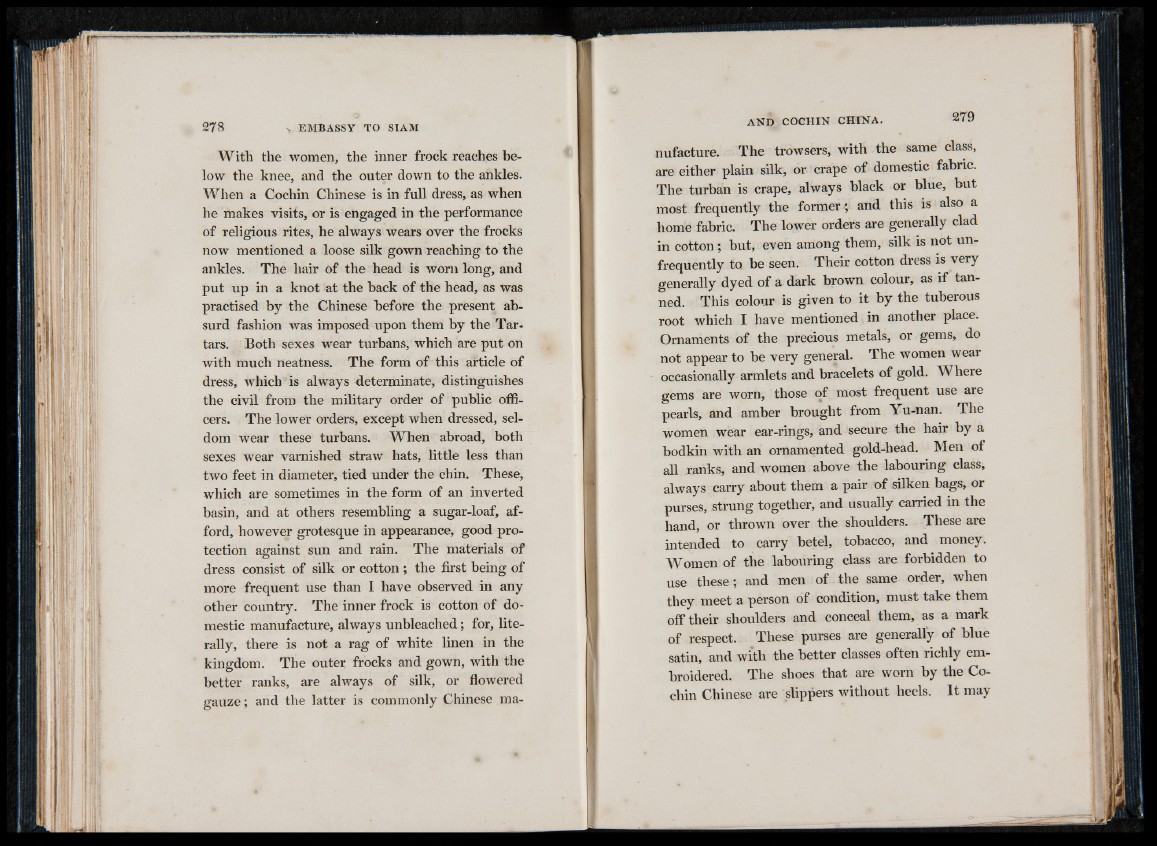
With the women, the inner frock reaches below
the knee, and the outer down to the ankles.
When a Cochin Chinese is in full dress, as when
he makes visits, or is engaged in the performance
of religious rites, he always wears over the frocks
now mentioned a loose silk gown reaching to the
ankles. The hair of the head is worn long, and
put up in a knot at the back of the head, as was
practised by the Chinese before the present absurd
fashion was imposed upon them by the Tartars.
Both sexes wear turbans, which are put on
with much neatness. The form of this article of
dress, which is always determinate, distinguishes
the civil from the military order of public officers.
The lower orders, except when dressed, seldom
wear these turbans. When abroad, both
sexes wear varnished straw hats, little less than
two feet in diameter, tied under the chin. These,
which are sometimes in the form of an inverted
basin, and at others resembling a sugar-loaf, afford,
however grotesque in appearance, good protection
against sun and rain. The materials of
dress consist of silk or cotton ; the first being of
more frequent use than I have observed in any
other country. The inner frock is cotton of domestic
manufacture, always unbleached; for, literally,
there is not a rag of white linen in the
kingdom. The outer frocks and gown, with the
better ranks, are always of silk, or flowered
gauze; and the latter is commonly Chinese manufacture.
The trowsers, with the same class,
are either plain silk, or crape of domestic fabric.
The turban is crape, always black or blue, but
most frequently the former ; and this is also a
home fabric. The lower orders are generally clad
in cotton ; but, even among them, silk is not un-
frequently to be seen. Their cotton dress is very
generally dyed of a dark brown colour, as if tanned.
This colour is given to it by the tuberous
root which I have mentioned in another place.
Ornaments of the precious metals, or gems, do
not appear to be very general. The women wear
occasionally armlets and bracelets of gold. Where
gems are worn, those of most frequent use are
pearls, and amber brought from Yu-nan. The
women wear ear-rings, and secure the hair by a
bodkin with an ornamented gold-head. Men of
all ranks, and women above the labouring class,
always carry about them a pair of silken bags, or
purses, strung together, and usually carried in the
hand, or thrown over the shoulders. These are
intended to carry betel, tobacco, and money.
Women of the labouring class are forbidden to
use these; and men of the same order, when
they meet a person of condition, must take them
off their shoulders and conceal them, as a mark
of respect. These purses are generally of blue
satin, and with the better classes often richly embroidered.
The shoes that are worn by the Cochin
Chinese are slippers without heels. I t may